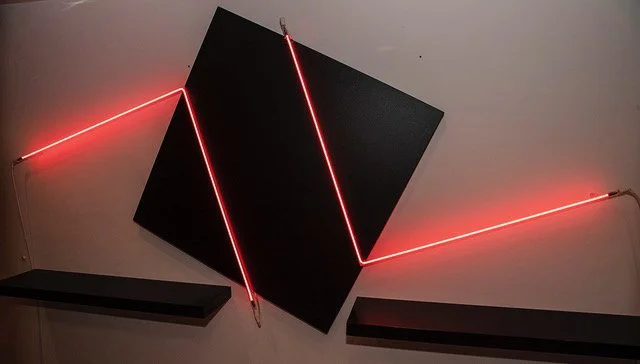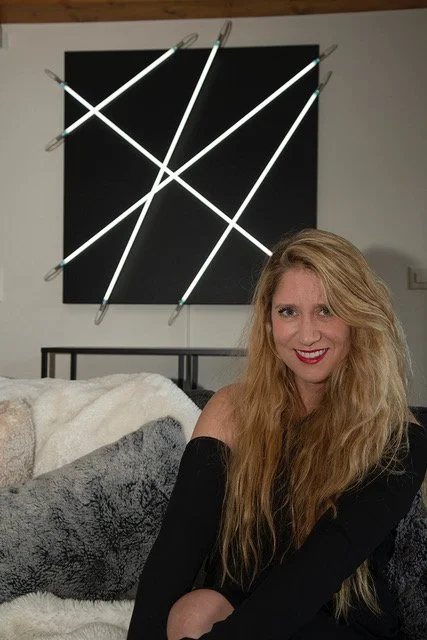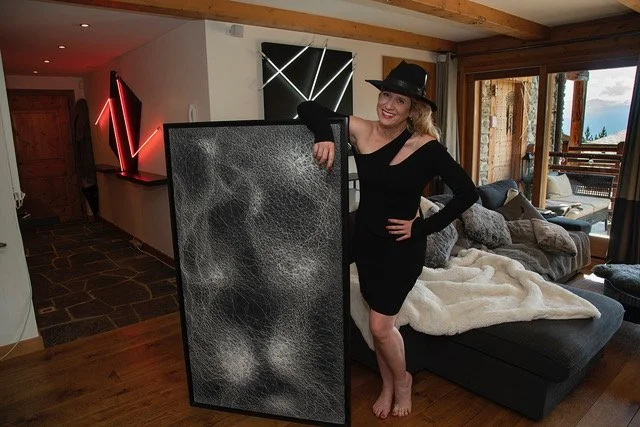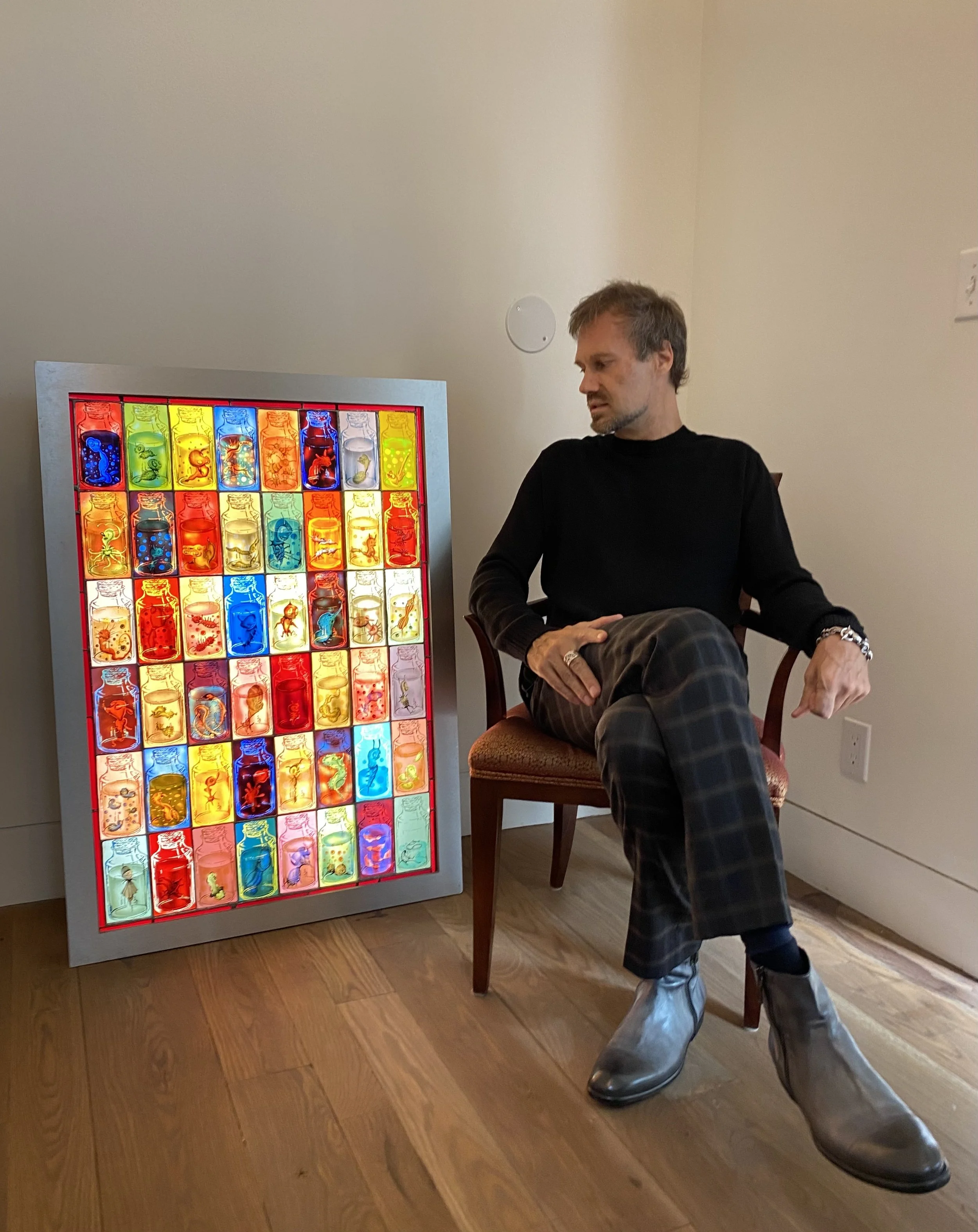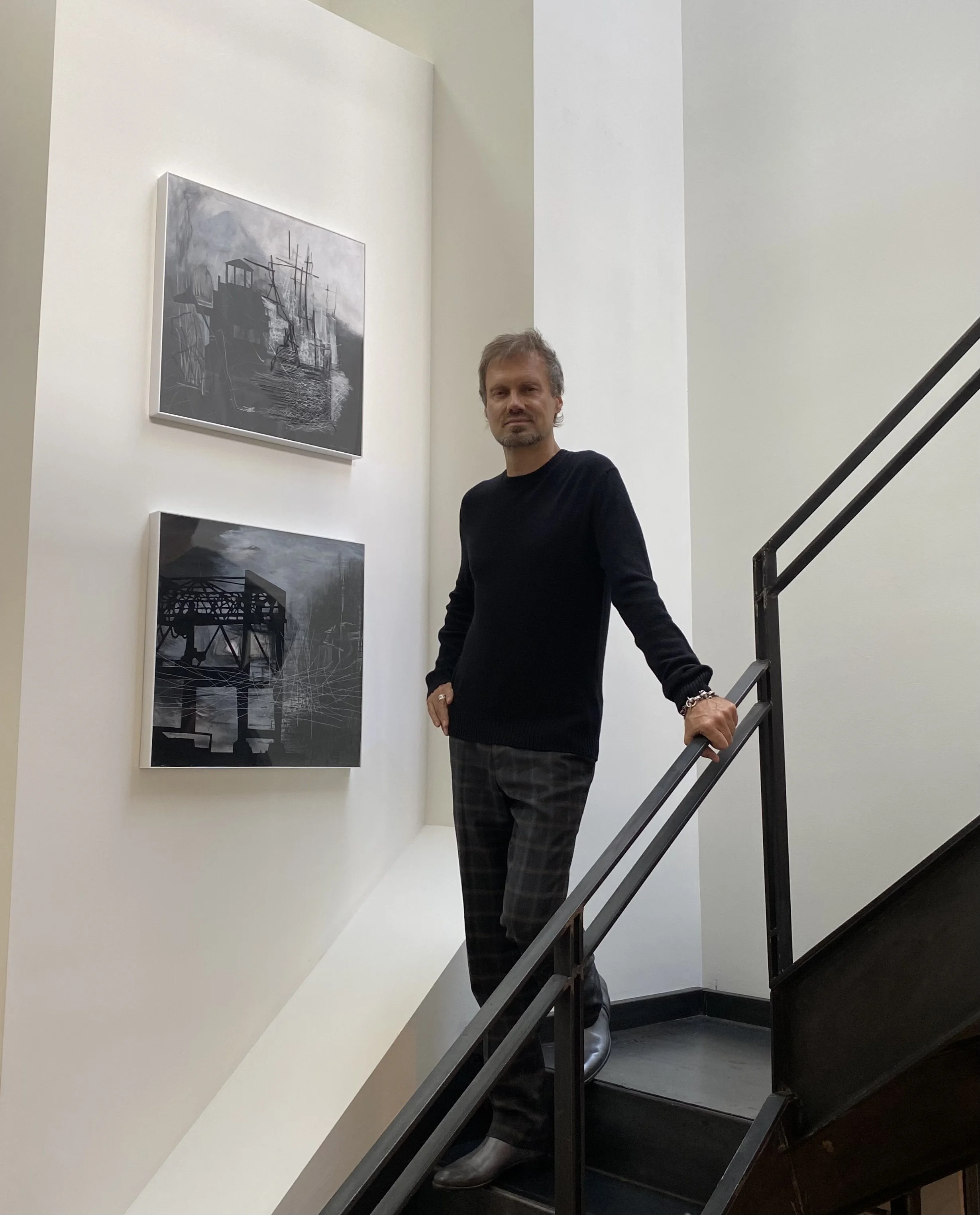Twenty Years of Loving Contemporary Art
The world of a passionate art collector,- Delphine de Causans is full of neons and no regrets. The ultimate happiness for her are the moments of philanthropy and giving back through arts.
The world of passionate art collector,- Delphine de Causans is full of neons and no regrets. The ultimate happiness for her, are the moments of philanthropy and giving back through arts.
INTERVIEW WITH ART COLLECTOR DELPHINE DE CAUSANS
From collector’s archives. Photographed by Peter Charaf.
Les Couleurs: If you could steal one work of art without getting caught, what would it be?
Delphine de Causans: Without a doubt that would be an action painting by Jackson Pollock. One of those made during the “drip period” between 1947 and 1950.
Les Couleurs: What work do you wish you had bought when you had the chance?
Delphine de Causans: Probably one of Damien Hirst’s spot paintings, a decade ago. Or an “Outrenoir” by Pierre Soulages. I have always been amazed by his ability to reveal the light from the black.
Les Couleurs: What is the most impractical work of art you own?
Delphine de Causans: A 133 x 274 cm neon and acrylic on canvas and wood!
Les Couleurs: What is your focus regarding the artists in your collection? Are you more interested in emerging or renowned artists?
Delphine de Causans: When I started studying the history of contemporary art, we focused more on renowned artists and art movements, and after working for auction houses and art galleries, I realized I was more interested in discovering the work of emerging artists. Yet some of the artists I collect are renowned, because I like what I like, and some of the emerging artists—I collect their work, and they become famous. It’s interesting to witness how the art world evolves.
Les Couleurs: What work do you have hanging above your sofa?
Delphine de Causans: In New York, there is a 1 x 1.5m acrylic, ink and charcoal on paper made by Todd DiCiurcio, an American artist whom I met at an art charity event, and who became a dear friend of mine. In Verbier [Switzerland], there is a 1 x 1m neon tube and acrylic on canvas on wood by French artist Francois Morellet.
Les Couleurs: If you could live with just one work of art, what would it be?
Delphine de Causans: That’s a tough one! Let’s say the first art piece I bought when I was twenty-ish years old at an auction in Paris. A watercolor and Indian ink on paper by French artist Henri Michaux.
Les Couleurs: What is the main motivation behind your collecting?
Delphine de Causans: First of all, I buy a work of art because it makes me feel something. I don’t think about making an investment or any kind of profit out of it. According to me when one buys an artwork, it is for it to be part of my four walls and admired every day. Each of the paintings, sculptures, photographs I bought has its own story. I also ask myself the usual questions when contemplating buying a piece: What does it bring to the art world? Is there a new medium, a new technique used in the making? Has the artist found a new way to express subjects or themes that we already know in some way?
Les Couleurs: When did you fall in love with a piece of art? What was it?
Delphine de Causans: It has been a little while now that I am keeping up with artist Tracy Emin and I just got a neon text which I will be receiving any time now!
Art collector Delphine de Causans. Photographed by Peter Charaf.
Les Couleurs: Is there a work you regret purchasing?
Delphine de Causans: No way!
Les Couleurs: How did it come about, your enthusiasm for art?
Delphine de Causans: Once I got my high school diploma I decided to study art history. Maybe it was some kind of rebellious act as I didn’t want to follow my parent’s footsteps by studying business. I found myself taken with art and I wanted to specialize in contemporary art mostly because I had a keen desire to properly understand this market which was new to me. Over time my enthusiasm for art has grown into an absolute passion. Wandering around both art fairs and galleries, reading, meeting artists... That's how I became an art collector. And, via the arts, I ended up working in business after all.
Les Couleurs: What was your happiest moment being involved in art?
Delphine de Causans: It’s hard to say, but probably when my artist friends donate work to the charities I sponsor. Charities that help kids in need through art such as Free Arts NYC or the Children’s Museum of the Arts NYC—they are so essential.
Art collector Delphine de Causans. Photographed by Peter Charaf.
Rockstar Art Collector
Torn between collecting are creating, Alex Skora finds time for both in his very hectic and busy life routine.
ALEX SKORA
INTERVIEW WITH ART COLLECTOR ALEX SKORA
ALEX SKORA
LES COULEURS: If you could steal one work of art without getting caught, what would it be?
ALEX SKORA: Twombly's "Say Goodbye, Catullus, to the Shores of Asia Minor". It's in the Menil Collection in Houston and is not only a tremendous piece, but the act of thievery would need to be of such operational genius that it would be the undisputed Thefts of Thefts. Because at the end of the day, it's more about the thrill than the kill.
LC: What work do you wish you had bought when you had the chance?
AS: There are more works that I wish I'd bought if I had the money—but that's the ultimate relative statement, isn't it?
LC: Tell us how did you start collecting art? What was your very first purchase?
AS: My parents were art collectors, but their sensibilities were more traditional and classicist. Nonetheless, their collecting somehow seeped into me, as our parents' influence will do. The first piece I bought was "Ikariad" by Zbigniew Blukacz, a Polish painter that I discovered in a gallery in Poznan. It was a piece that intuitively reflected the Zeitgeist in Poland at the time he painted it. I've had it ever since purchasing it in 1990, and I now have it hanging on my bedroom wall. While I happen to be half Polish, I'm not sure what my decision to start and end my day with post-Soviet Polish existential angst says about me.
LC: What was your happiest moment being involved in art?
AS: I occasionally host art events that bring together artists that work in different mediums and have them collaborate on pieces together. It's very free-form, improvisational, and low-pressure. Everybody hangs out, drinks a bit (sometimes more than a bit), and then has fun collaborating. The creation of art is generally a solitary process, so the artists appreciate the opportunity to work with other artists in a supportive and collegial way. It's basically a jam session with canvas and paint. None of it is about money, it's just about making art and bonding. Those evenings always end with a smile for me.
LC: What was your most recent purchase?
AS: A piece by Brooklyn artist Jay Riggio that I bought literally on the eve of the pandemic. After I brought it home, my daughter expressed her approval, so I know that I now have at least one honest vote of encouragement for the acquisition.
LC: How are you discovering new artists these days?
AS: It seems like the best way to discover art in person during the past year or so has been on a bicycle checking out street art, because the online format doesn't really work—at least for me. But galleries are starting to open up again, and the mask does make for a perfect art world style accessory. I think that it should be mandatory even for post-pandemic art events because it may force some people to say less.
Alex Skora
LC: What is your art-world pet peeve?
AS: The awful preciousness of some of the interactions in that world. I'm not a fan of blathering pontifications about the hyperbolic meaning of a work of art. I am a simple person. I like what I like. Don't try to use a long sentence to convince me otherwise.
LC: Tell us about Love Crushed Velvet.
AS: LCV is my vehicle for musical collaboration and expression. It's "band" in the same way that Nine Inch Nails or Bright Eyes are a band—a songwriter acting as a hub for whoever wants to collaboratively step into a borderless space and see what happens. I've released a good bit of material through Love Crushed Velvet, written even more, and have now started collaborating with digital visual artists to make music videos in virtual reality. I'm a horrendously inept and highly reluctant self-promotor, so most of what I release enters the world without a great deal of fanfare, but it's still rock and roll, so if you let your guard down it might hit you. If I were to be struck by a bus tomorrow, I'd enter the afterlife feeling that I'd created music that I'm genuinely proud of. If you're bold enough to click "play", lovecrushedvelvet.com will keep you busy for an hour or two.
ALEX SKORA
Beyond Dental Arts
“Oral health care for paintings. I guess you could say I was a true patron of the arts.” -Todd Bertman
“Oral health care for paintings. I guess you could say I was a true patron of the arts.” -Todd Bertman
INTERVIEW WITH ART COLLECTOR TODD BERTMAN
DR. BERTMAN
LES COULEURS: How did it come about, your enthusiasm for art? When did you start collecting art?
TODD BERTMAN: I have always had a love for the arts at a young age, not just paint but other mediums as well. In high school, I painted my room, resurfaced the wood floors, and redesigned it at least once a year. When my parents put an end to that, I started building remote control planes and cars. I think I had a thing for building and creating in general. In fact, I named my first practice in midtown Manhattan Advanced Dental Arts because I always believed creating a great smile was a combination of art and science.
LC: When did you start collecting art?
TB: I started collecting art about 15 years ago. Many new artists, some starting in the streets of NYC ended up in my office. They had no insurance and very little money. But they needed help. So I would barter. Oral health care for paintings. I guess you could say I was a true patron of the arts. Most of these artists really hustled! They sold on the streets, local markets, and galleries. It was inspiring.
LC: What was your happiest moment being involved in art?
TB: There are many happy moments but the most satisfying ones are seeing the kids in Haiti and Mexico benefiting from Les Couleurs Charity. It's a one of a kind organization!
LC: Can you name three emerging artists which should be on our watchlist?
TB: Angela China. Angela started in the streets of NYC, mostly tagging walls in the Lower East Side with her signature 'Legs and heels', very recognizable. She focused and put herself through a top art school in NYC. She is continually developing her skills, in combination with her natural talent. Unstoppable.
Syltartist. Syltartist is from Montreal. I've seen his work develop over the years and his work is fantastic.
Dom Pattinson. Dom is from England and although some of Dom's work is collected by the likes of many celebs (like Brad Pitt). He's a talented gentleman and underexposed.
LC: You have been a great supporter of Les Couleurs Charity, a non-profit organization that provides orphanage children in Haiti and Mexico with arts education. Why do you think it's important?
TB: Les Couleurs Charity is simply a gem! The story of how it developed and continues to develop is one of courage, perseverance, and selflessness. When I heard about it I was compelled and humbled by its intentions. We need to continue its mission and philosophy of educating underprivileged children through arts education and creativity. Art has always shaped and defined culture and vice versa. Fundamentally, it is creativity and imagination that is necessary for growth, Les Couleurs fosters that for these children that otherwise may never experience it.
LC: What is your advice to young and fresh collectors?
TB: That's simple, don't think too much and just buy what you like!
LC: How are you discovering new artists these days?
TB: The easiest way is to jump on Instagram. Check out some artists that you like and see who they are following. Or head down to the local galleries. But the best is when I'm traveling and exploring the local spots. That's always fun.
LC: Tell us about the documentary you are working on.
TB: It's called Beyond the Canvas. It's a docuseries with each episode highlighting a single artist, and their deeply personal stories, inspirations, and unique styles. I shot two episodes and working on the third. I'm speaking with some networks at the moment that may pick it up.
LC: How important is it for you to meet the artists who created the artwork?
TB: For me, I need that connection. It makes it a more meaningful experience.
Dr. Bertman in his New York City office
A Glimpse Inside a Private Collection of a True Art Lover
“I’m motivated by the passion that an artist puts into the creative process.”
-Pablo Annovelli
“I’m motivated by the passion that an artist puts into the creative process.” -Pablo Annovelli
INTERVIEW WITH ART COLLECTOR PABLO ANNOVELLI
Collector PABLO ANNOVELLI
LES COULEURS: What is your focus regarding the artists in your collection?
Pablo Annovelli: I am focusing now on contemporary Latin American art, particularly artists that have made a significant impact in the US. However, the local art scene in Miami has grown so much, that I’m considering this as an addition.
LC: Are you more interested in emerging or renowned artists?
PA: I try to lean towards the more established artists, but I have a little bit of everything in my collection.
LC: If you could live with just one work of art, what would it be?
PA: Out of my collection: Velocity by Fabian Burgos, one of the first pieces that I acquired and is part of the layout here in Downtown Miami. You may recognize the series as the exterior of Brickell Heights and the SLS Lux buildings. But, if I have to choose from the whole universe of arts, probably anything from Roy Lichtenstein.
FABIAN BURGOS
Velocity
LC: When did you fall in love with a piece of art? What was it?
PA: I fell in love with a collaboration between Andy Warhol and Martha Minujin, “Payment of the Argentine Foreign Debt to Andy Warhol with Corn” at my first Miami Art Basel in 2006. I was able to buy the piece at Minujin’s Studio many years later, and it was one of my happiest moments as a collector.
Payment of the Argentine Foreign Debt to Andy Warhol with Corn
LC: What is your most treasured artwork?
PA: “Untitled” by Alfredo Esposito, not only it is one of the most impactful pieces of the collection, but he is an amazing person and a great friend of mine.
LC: What was your most recent purchase?
PA: I bought “To Come Back”, by Liliana Porter at Ruth Benzacar’s gallery in Buenos Aires. I always wanted to have a piece by her, and this just came at the right moment.
LC: What is your biggest regret regarding collecting?
PA: It has to do with the Online Auctions, I regret to be too conservative to pull the trigger on some of them. I tend to buy most of my pieces at the art fairs and galleries.
LC: Which works or artists are you hoping to add to your collection this year?
PA: I’m looking to get a piece by Vik Muniz. I follow his career since I met him at the Miami Art Museum (Now PAMM), and I still have one of his books he signed for me that day. Also I am looking to add a Rogelio Polesello and a piece by Martha Boto that I saw in Midtown.
LC: How are you discovering new artists these days?
PA: It’s very hard right now, I’ve been participating in the Perez Art Museum virtual gatherings and trying to keep up online. But the ecosystem needs Art Shows and Museum events. I’m looking forward to 2021 in that respect. In the meantime, I’m looking to secure some of the art that I already know and love.
LC: How important is it for you to meet the artists who created the artwork?
PA: It’s important to some extent, but not a deal-breaker for me. I love to meet and learn from the artist as much as I can, but sometimes a work of art speaks for itself. Sometimes I don’t even want to know the details because I’m looking at it from my point of view and I love it.
LC: What made you want to start collecting art? What is the main motivation behind your collecting?
PA: Long before buying my first piece of art, I become a member of the local museums, where I had the opportunity to chat with great curators, and also to sign up for as many private collector visits as I could. After I had learned from these institutions, as well as from other art collectors that were kind enough to share their passion with me, I started my journey and never looked back. I’m motivated by the passion that an artist puts into the creative process. And as a collector, my hope is to leave a legacy that can be improved by the next generations.


